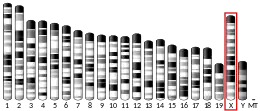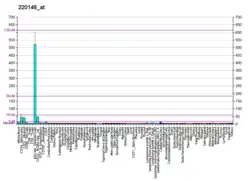Toll-like receptor 7
Toll-like receptor 7, also known as TLR7, is a protein that in humans is encoded by the TLR7 gene. Orthologs are found in mammals and birds.[5] It is a member of the toll-like receptor (TLR) family and detects single stranded RNA.
Function
The TLR family plays an important role in pathogen recognition and activation of innate immunity. TLRs are highly conserved from Drosophila to humans and share structural and functional similarities. They recognize pathogen-associated molecular patterns (PAMPs) that are expressed on infectious agents, and mediate the production of cytokines necessary for the development of effective immunity. The various TLRs exhibit different patterns of expression. This gene is predominantly expressed in lung, placenta, and spleen, and lies in close proximity to another family member, TLR8, on the human X chromosome.[6]
TLR7 recognizes single-stranded RNA in endosomes, which is a common feature of viral genomes which are internalised by macrophages and dendritic cells. TLR7 recognizes single-stranded RNA of viruses such as HIV and HCV.[7][8] TLR7 can recognize GU-rich single-stranded RNA.[7] However, the presence of GU-rich sequences in the single-stranded RNA is not sufficient to stimulate TLR7.[8]
Clinical significance
TLR7 has been shown to play a significant role in the pathogenesis of autoimmune disorders such as lupus as well as in the regulation of antiviral immunity.[9][10] Although not yet fully elucidated, using an unbiased genome-scale screen with short hairpin RNA (shRNA), it has been demonstrated that the receptor TREML4 acts as an essential positive regulator of TLR7 signaling. In TREML4 -/- mice macrophages that are hyporesponsive to TLR7 agonists, macrophages fail to produce type I interferons due to impaired phosphorylation of the transcription factor STAT1 by the mitogen-activated protein kinase p38 and decreased recruitment of the adaptor MYD88 to TLR7. TREML4 deficiency reduced the production of inflammatory cytokines and autoantibodies in MRL/lpr mice, suggesting that TLR7 is a vital component of antiviral immunity and a predecessor factor in the pathogenesis of rheumatic diseases such as systemic lupus erythematosus (SLE).[11] A TLR7 agonist, imiquimod (Aldara),[12] has been approved for topical use in treating warts caused by papillomavirus and for actinic keratosis.[13]
Due to their ability to induce robust production of anti-cancer cytokines such as interleukin-12, TLR7 agonists have been investigated for cancer immunotherapy. Recent examples include TMX-202 delivery via liposomal formulation,[14] as well as the delivery of resiquimod via nanoparticles formed from beta-cyclodextrin.[15]
In July 2020, it was discovered that loss-of-function variants in TLR7 cause young men patients to become seriously ill after being infected by SARS-CoV-2.[16] This suggests that TLR7 plays a key role in triggering the immune response for patients of COVID-19. For more details on the biological mechanism and pathway, see "Type I Interferon Induction and Signaling During SARS-CoV-2 Infection" on WikiPathways. In contrast, gain-of-function variation in TLR7 was shown in 2022 to cause systemic lupus erythematous and neuromyelitis optica in humans.[17]
References
- 1 2 3 GRCh38: Ensembl release 89: ENSG00000196664 - Ensembl, May 2017
- 1 2 3 GRCm38: Ensembl release 89: ENSMUSG00000044583 - Ensembl, May 2017
- ↑ "Human PubMed Reference:". National Center for Biotechnology Information, U.S. National Library of Medicine.
- ↑ "Mouse PubMed Reference:". National Center for Biotechnology Information, U.S. National Library of Medicine.
- ↑ Du X, Poltorak A, Wei Y, Beutler B (September 2000). "Three novel mammalian toll-like receptors: gene structure, expression, and evolution". European Cytokine Network. 11 (3): 362–371. PMID 11022119.
- ↑ "Entrez Gene: TLR7 toll-like receptor 7".
- 1 2 Heil F, Hemmi H, Hochrein H, Ampenberger F, Kirschning C, Akira S, et al. (March 2004). "Species-specific recognition of single-stranded RNA via toll-like receptor 7 and 8". Science. 303 (5663): 1526–1529. Bibcode:2004Sci...303.1526H. doi:10.1126/science.1093620. PMID 14976262. S2CID 1680581.
- 1 2 Zhang Y, El-Far M, Dupuy FP, Abdel-Hakeem MS, He Z, Procopio FA, et al. (July 2016). "HCV RNA Activates APCs via TLR7/TLR8 While Virus Selectively Stimulates Macrophages Without Inducing Antiviral Responses". Scientific Reports. 6: 29447. Bibcode:2016NatSR...629447Z. doi:10.1038/srep29447. PMC 4935957. PMID 27385120.
- ↑ Brown GJ, Cañete PF, Wang H, Medhavy A, Bones J, Roco JA, et al. (May 2022). "TLR7 gain-of-function genetic variation causes human lupus". Nature. 605 (7909): 349–356. Bibcode:2022Natur.605..349B. doi:10.1038/s41586-022-04642-z. PMC 9095492. PMID 35477763. S2CID 248414899.
- ↑ Jenks SA, Cashman KS, Zumaquero E, Marigorta UM, Patel AV, Wang X, et al. (October 2018). "Distinct Effector B Cells Induced by Unregulated Toll-like Receptor 7 Contribute to Pathogenic Responses in Systemic Lupus Erythematosus". Immunity. 49 (4): 725–739.e6. doi:10.1016/j.immuni.2018.08.015. PMC 6217820. PMID 30314758.
- ↑ Ramirez-Ortiz ZG, Prasad A, Griffith JW, Pendergraft WF, Cowley GS, Root DE, et al. (May 2015). "The receptor TREML4 amplifies TLR7-mediated signaling during antiviral responses and autoimmunity". Nature Immunology. 16 (5): 495–504. doi:10.1038/ni.3143. PMC 4406861. PMID 25848864.
- ↑ Hemmi H, Kaisho T, Takeuchi O, Sato S, Sanjo H, Hoshino K, et al. (February 2002). "Small anti-viral compounds activate immune cells via the TLR7 MyD88-dependent signaling pathway". Nature Immunology. 3 (2): 196–200. doi:10.1038/ni758. PMID 11812998. S2CID 1694900.
- ↑ Vender RB, Goldberg O (January 2005). "Innovative uses of imiquimod". Journal of Drugs in Dermatology. 4 (1): 58–63. PMID 15696986.
- ↑ Klauber TC, Laursen JM, Zucker D, Brix S, Jensen SS, Andresen TL (April 2017). "Delivery of TLR7 agonist to monocytes and dendritic cells by DCIR targeted liposomes induces robust production of anti-cancer cytokines". Acta Biomaterialia. 53: 367–377. doi:10.1016/j.actbio.2017.01.072. PMID 28153581.
- ↑ Rodell CB, Arlauckas SP, Cuccarese MF, Garris CS, Li R, Ahmed MS, et al. (August 2018). "TLR7/8-agonist-loaded nanoparticles promote the polarization of tumour-associated macrophages to enhance cancer immunotherapy". Nature Biomedical Engineering. 2 (8): 578–588. doi:10.1038/s41551-018-0236-8. PMC 6192054. PMID 31015631.
- ↑ van der Made CI, Simons A, Schuurs-Hoeijmakers J, van den Heuvel G, Mantere T, Kersten S, et al. (August 2020). "Presence of Genetic Variants Among Young Men With Severe COVID-19". JAMA. 324 (7): 663–673. doi:10.1001/jama.2020.13719. PMC 7382021. PMID 32706371.
- ↑ Brown GJ, Cañete PF, Wang H, Medhavy A, Bones J, Roco JA, et al. (May 2022). "TLR7 gain-of-function genetic variation causes human lupus". Nature. 605 (7909): 349–356. Bibcode:2022Natur.605..349B. doi:10.1038/s41586-022-04642-z. PMC 9095492. PMID 35477763.
Further reading
- Lien E, Ingalls RR (January 2002). "Toll-like receptors". Critical Care Medicine. 30 (1 Suppl): S1-11. doi:10.1097/00003246-200201001-00001. PMID 11782555.
- Kaisho T, Akira S (February 2002). "Toll-like receptors as adjuvant receptors". Biochimica et Biophysica Acta (BBA) - Molecular Cell Research. 1589 (1): 1–13. doi:10.1016/S0167-4889(01)00182-3. PMID 11909637.
External links
- Toll-Like+Receptor+7 at the U.S. National Library of Medicine Medical Subject Headings (MeSH)




